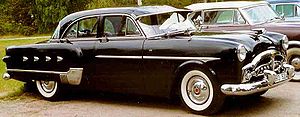The Packard cars were some of the finest and best built cars in America for several decades of the twentieth century when I was growing up and through my adult years. I owned one Packard for a little while about 1952 or 1953. I saw one car like this one, but I don't remember for certain whether it was a Packard or not, that was fixed up like a small living room with a small bar and whiskey storage, a card table and telephone and maybe some other things in it. I tend to think of this car as one that Al Capone or John Dillinger or "Baby Face" Nelson might have had some 30 or 40 years earlier during the Prohibition Years.
The following pictures and articles are taken from the internet Wikipedia encyclopedia
Packard Patrician 400, 1951–1952[edit]
| Packard Patrician 1951-1952 | |
|---|---|
| Overview | |
| Manufacturer | Packard |
| Production | 1951–1952 |
| Body and chassis | |
| Body style | Sedan |
| Layout | FR |
| Powertrain | |
| Engine | Packard Straight Eight 327 cu in (5,360 cm3), 150 bhp (112 kW) |
| Transmission | Ultramatic |
| Dimensions | |
| Wheelbase | 3226 mm (127 in) |
| Length | 5580 mm (219,70 in) |
| Width | 1990 mm (78,3 in) |
| Height | 1580 mm (62.2 in) |
The highest trim level available was the Packard Patrician 400. The Patrician 400 replaced the previous model year's Custom 8 model range. The car was easily identified from other Packards by its chrome trim; in 1951 the model featured three chrome ports on its rear fenders and in 1952 the car featured four chrome ports. Patricians and 300s also sported a slightly revised grille which included chrome "teeth" in its oval area in 1951. That change occurred to the 250 series soon after introduction.
The Patrician 400 was available only as a premium, four-door sedan, outfitted with high-grade upholstery and chrome trimming within. For the 1952 model year, Packard retained the services of noted interior decorator Dorothy Draper to bring a fresh look to the interior color scheme. Wilton carpeting and hassock-style rear passenger foot rests were also included with the car. With a list price of $3,662 it also was the most expensive regular Packard offered. The automobile rode upon a 127-inch (3226 mm) wheelbase shared only with the 300 sedan. All other Packards had a wheelbase of 122 inches (3099 mm).
Power for all Packards still came from their venerable in-line eight-cylinder engines. 200s used a 288 cu in (4,720 cm3) unit with 135 bhp (101 kW); all others had a displacement of 327 cu in (5,360 cm3), delivering 150 bhp (112 kW). The Patrician got the best engine Packard had to offer, too. For unequaled smooth operation, its engine featured nine main bearings instead of five as in the other engines without increase in power.
Until 1954, Henney built a few nine-passenger Executive Sedans and Corporate Limousines on a chassis with 148-inch (3759 mm) wheelbase. Derham in Rosemont built very few Patrician Custom Formal Sedans with leather padded roofs, small backlights and elaborate interiors on the standard Patrician frame.
Introduction of the Patrician was, together with most other Packards (250s were delayed), in August 1950. Production totals for 1951 came to 9,001 Patrician 400 units, and 3,975 units for 1952.
The 400 model name was dropped for model years 1953 and 1954; however the Patrician name continued to occupy the premium trim level Packard from 1953 through 1956.
1955–1956[edit]
| Packard Patrician 1955-1956 | |
|---|---|
| Overview | |
| Manufacturer | Packard |
| Production | 1955–1956 |
| Designer | Richard A. Teague |
| Body and chassis | |
| Body style | Sedan |
| Layout | FR |
| Powertrain | |
| Engine | Packard 6.2 1956 V-8 372.5 cid (6135 cc), 290 ps, 211,94kW |
| Transmission | Twin-Ultramatic |
| Dimensions | |
| Wheelbase | 3226 mm (127 in) |
| Length | 5580 mm (219,70 in) |
| Width | 1990 mm (78,3 in) |
| Height | 1580 mm (62.2 in) |
| Curb weight | 2075 kg (4551,73 lbs) |
For 1955, the Patrician was offered as a four-door sedan only and Packard produced 9,127 of the cars.
Changes for 1956 included a revised headlight housing that exaggerated the front peak further forward. The area around the headlight was painted black to give the effect of greater depth. The car also received a different grille texture. During the 1956 model year, 3375 Patricians rolled off Packard's production line before the model was dropped by the ailing carmaker.
The final Packard built (that was a true Packard and not a badge-engineered Studebaker President) was a black Patrician sedan, and it rolled off the Packard assembly line on June 25, 1956.



No comments:
Post a Comment